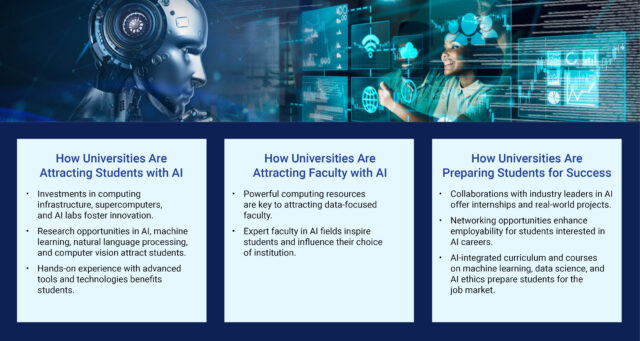My friend Maria, who is 22 years old, told me that she often decides if she is going to continue dating someone by asking an artificial intelligence (AI) tool to give her an opinion based on the content of their social media chats. If young, college-age people are asking AI for relationship advice, they’re likely asking AI for advice on which universities to apply to and attend. Their generation has grown up in a world where AI and computer science are not just fascinating futuristic concepts on TV, but instead an integrated part of everyday life. Universities that are not promoting access to AI resources to potential students may soon find themselves in as much jeopardy as Maria’s partner.
What’s the Difference Between HPC and AI?
Most universities have offered researchers high-performance computing (HPC) resources for years. HPC offers unmatched computational power for performance-intensive simulations that demand massive parallelism, such as simulating fluid dynamics, molecular dynamics, climate modeling, astronomy and more. AI thrives on large amounts of labeled data for machine learning models, neural networks and deep learning architectures. AI’s ability to process information efficiently and intelligently to extract patterns and insights from this data drives innovation.
HPC for AI
HPC technologies are pivotal for developing AI models, as they can handle the vast data repositories generated from traditional HPC tasks, turning them into valuable assets for AI. HPC not only aids in creating datasets for AI but also enhances financial simulations like Monte Carlo methods, where AI can step in to offer more precise and timely interpretations of the growing data.
AI for HPC
Conversely, AI can streamline the workload for HPC systems by pre-processing data, narrowing down possibilities for HPC to analyze more thoroughly and even substituting extensive HPC computations with AI-generated approximations. This synergy between HPC and AI leads to a powerful combination that boosts the accuracy and efficiency of both technologies, fostering significant advancements in computational tasks.
Combining the Power of HPC with the Efficiency of AI
The symbiotic relationship between HPC and AI is reshaping the technology landscape at universities, driving innovation at an unprecedented pace. AI is no longer a separate entity; it has become an integral part of HPC. AI is now considered one of the essential components of HPC workloads. Organizations need infrastructure that seamlessly supports both HPC and AI workloads to remain competitive in today’s rapidly changing landscape.
PC and AI Trends in Higher Education
Academic supercomputing centers are hubs for scientific discovery. A 2024 study by industry analyst Intersect360 identifies a trend in amplifying scientific research with the latest in artificial intelligence. According to Intersect360 Research, over 90% of academic HPC centers have made investments to incorporate AI into their research.
This is most evident in the incorporation of graphics processing units (GPUs), the computational elements that have powered the revolution in AI. The study found that 92% of academic HPC centers have incorporated computational accelerators, and 91% of accelerated HPC workloads are leveraging GPUs from NVIDIA.
The major trend driving recent growth has been the promise of generative AI (GenAI)—AI capable of creating original content, whether in writing, art or computer code. The study found that 35% of academic HPC-AI sites are “actively using generative AI” while 37% are “looking at building their own generative AI models.”
The Year of AI at the University of Texas at Austin
The University of Texas at Austin (UT-Austin) is ranked in the top 10 nationally for AI. In February 2024, the University launched the Center for Generative AI and announced that 2024 is the “Year of AI” at the university.
UT-Austin has a rich history of innovation in technology through the Texas Advanced Computing Center (TACC). In fact, the U.S. National Science Foundation (NSF) selected TACC’s supercomputers, including the new AI-centric system Vista with 600 NVIDIA GH200 GPUs, to be part of the National Artificial Intelligence Research Resource pilot. The pilot provides U.S.-based researchers and educators with tools and data to advance AI research. Vista is a precursor to the Horizon system, set to be the largest NSF supercomputer, offering unparalleled computing power for scientific research by 2025.
“AI has become critically important to supercomputing centers, both as the importance of AI in science has grown, and as the infrastructure needed for large scale generative AI and high-performance computing has become virtually identical,” said Dan Stanzione, Executive Director, TACC / Associate Vice President for Research, UT-Austin. “Our newest system at TACC, Vista, has been designed with generative AI systems in mind. With 600 GH200 NVIDIA GPUs, it will vastly expand our capacity to support students and researchers in AI work. We’ve seen explosive demand for these resources, and more from the students than the faculty!”
Breaking Enrollment Records at UT-Austin
While it’s challenging to quantify the direct impact of AI investments on enrollment, UT-Austin’s commitment to AI research, faculty expertise and cutting-edge facilities likely contribute to its appeal among prospective students. UT-Austin received almost 73,000 undergraduate applications for the Fall 2024 semester, breaking the previous enrollment record for the UT System’s flagship university, set in 2022. In 2022, UT-Austin enrolled 66,109 students. The university also set all-time highs for graduation rates. The four-year graduation rate rose to 73.5% in 2022, an increase of 21 percentage points since 2012.
Universities must recognize the opportunity to incorporate HPC and AI, as failure to promote access to these resources could jeopardize their competitiveness in higher education. The exponential growth in AI integration, exemplified by UT-Austin’s commitment, not only amplifies scientific research but also attracts prospective students, evident in the university’s record-breaking enrollment figures.
Download the infographic from Intersect360 Research, “Powering Discovery: The rise of AI in academic supercomputing.”



